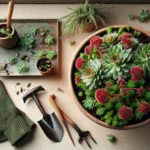Introduction to Sedum Flowers
Welcome to the resilient world of Sedum, a plant with plucky perseverance that manifests as a delightful display of blooms! Often praised for their drought-defying talents, these succulents are a testament to nature’s adaptability. Sedum flowers, with their come-what-may attitude, are not just survivors; they are the thriving emblems of gardens everywhere. Drought? Heatwaves? No fuss for Sedum, as these plants are practically the Spartans of the succulent world.
Flexibility is the hallmark of Sedum flowers when it comes to landscaping. Imagine a carpet of Sedum adorning rockeries with their textural foliage, spicing up those sunny spots of the garden where other plants might shy away. They are the perfect candidates for those neglected corners, bringing life and color without demanding constant attention. With this botanical swiss-army knife in your gardening arsenal, envision a garden that evolves from green to grandiose!
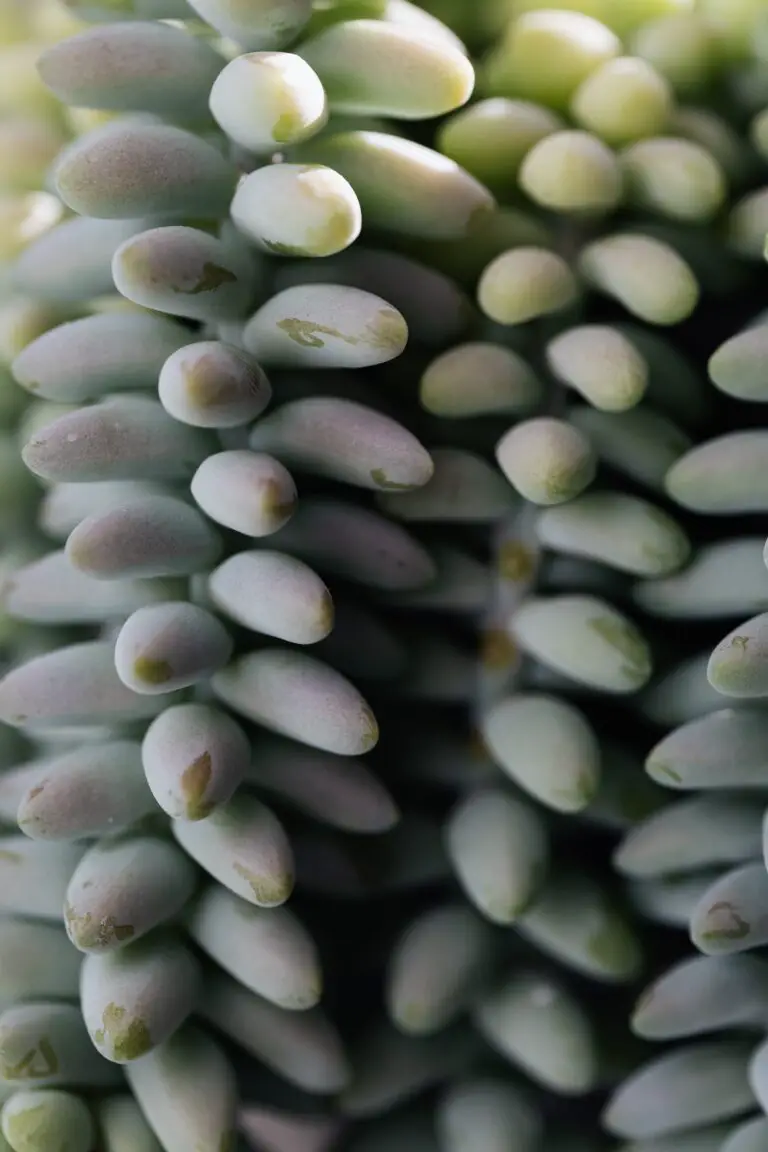
In the tapestry of garden design, Sedum flowers are the sturdy stitches holding patterns together. They whisper stories of xeriscaping achievements and spin tales of green roofs turned wildlife havens. In every Sedum, there lies a narrative of not just survival but ecological contribution; these plants are friends to pollinators, beckoning bees and butterflies into their embrace. So let’s embark on this explorative journey, discovering how such a modest plant can make a monumental impact on our gardens and environment.
The Diversity of Sedum Species
Wander through a vibrant tapestry of succulent beauty, and you’ll likely stumble upon the resilient yet delicate gem of gardens—the sedum flower. Also known as stonecrops, these plants are celebrated for their versatility and visual appeal. The sedum genus encompasses a fascinating array of species, each with its own tale to tell.
Take for instance the stalwart Sedum spectabile, or the ‘Autumn Joy’, as it’s affectionately known by gardening aficionados. With stout stems reaching heavenwards, this species boasts dense clusters of star-shaped flowers that transition from soft pink to a rich bronze as summer gives way to fall. It stands unwaveringly through heat, cold, and drought, asking little but offering a bounty of beauty and a safe haven for pollinators.
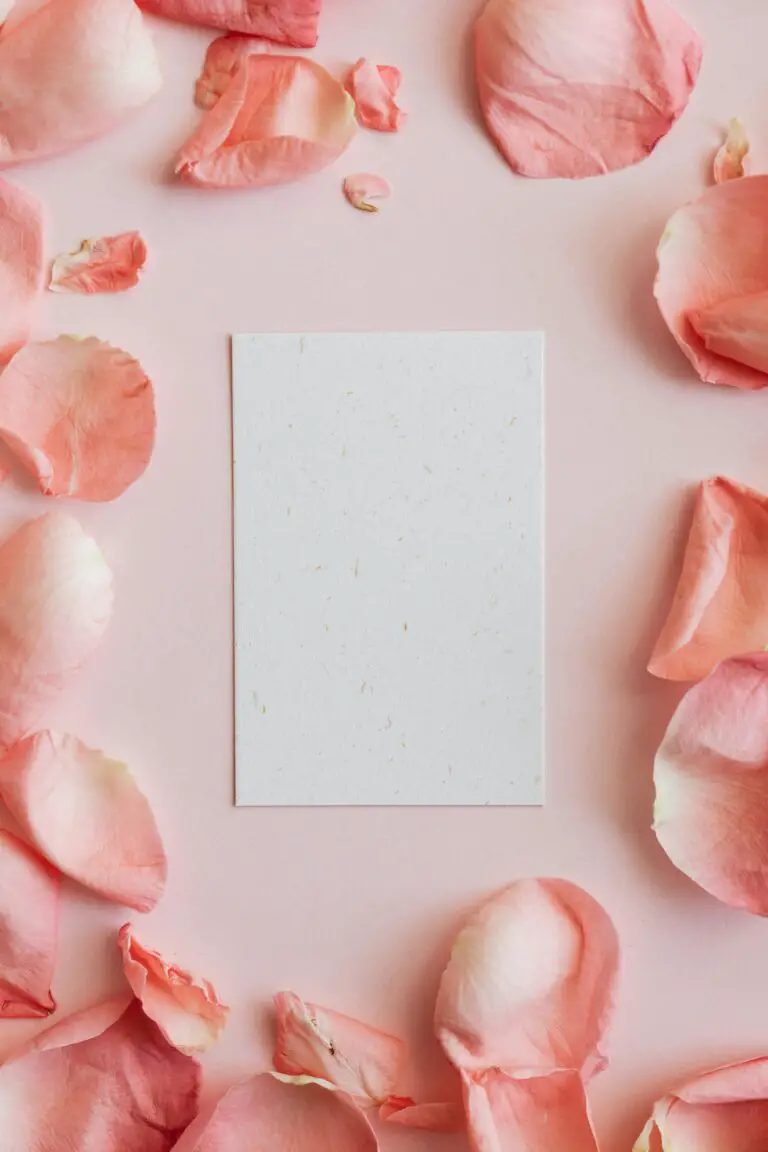
Conversely, the Sedum acre, or ‘Goldmoss’, is a ground-hugging champion, spreading its golden floral carpet far and wide. This low-growing dynamo is ideal for rock gardens or crevices that crave a touch of whimsy. Basking in full sun, Goldmoss thrives with minimal fuss, its tenacity against trampling feet indirectly echoing the steadfast nature of succulent enthusiasts.
In the realm of rooftop gardening, the hardy Sedum album, known as ‘White Stonecrop’, emerges as a heroic solution to greening urban spaces. This intrepid species forms a living blanket of succulent leaves, dotted with white blossoms under the summer sky—a testament to the adaptability and ecological benefits embraced in sedum’s DNA.
Equally noteworthy is the Sedum spurium, or ‘Dragon’s Blood’, a fantastical name befitting its dramatic foliage. With leaves that morph from green to deep red, and rosy flowers that blanket its form, this sedum captures the imagination. It’s a favorite for gardeners looking to inject a surge of color and character into their landscape.
As one explores these diverse sedum offerings, from the mighty monarchs to the modest minions, one understands the allure of these plants. They embody resilience, require sparing care, and yet yield a rich array of textures and hues—truly exemplifying the phrase “diversity in beauty.”
Planting and Caring for Sedum
When bringing the steadfast beauty of sedum flowers into your garden, begin by choosing a sunny locale. The resilience of these succulents shines brightest with ample sunshine, although they can forgive you with some shade. Think of it as providing a stage for a tireless performer—the right lighting makes all the difference!
Now let’s talk soil—these hardy gems are no divas. A well-draining mix avoids the dread of “wet feet.” Imagine your sedum sipping just the right amount of water without the risk of soggy roots. Layer in some gravel or perlite and witness the ideal home for your growing sedum take form.
Indulge your green thumb! Get down and dirty by planting sedum during the tranquility of spring or the golden whispers of fall. Space them about 6 to 18 inches apart, as these beauties tend to sprawl with the joy of a child in an open field. Here’s an insider’s tip: established sedum plants tolerate drought like seasoned warriors, but your young recruits appreciate consistent moisture as their roots take hold.
When the heavens open up, and rain arrives, fear not—for sedum plants relish water from above as long as the soil drains it away with urgency. Drooping leaves tell tales of thirst, so in the absence of rain, a thorough watering is your cue. However, moderation is key; think of it as a refreshing drink, not a flood!
Fertilizing is the secret handshake between gardener and flower. A light touch with a balanced, slow-release fertilizer welcomes a bounty of blooms. But know when to step back—in the serene slumber of winter, your sedum much prefers to rest without a meal.
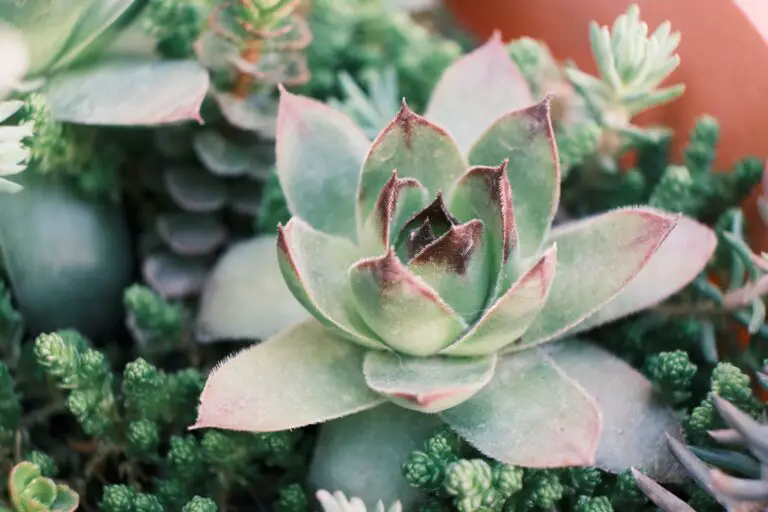
Behold the simplicity of maintenance—it’s like a gentle dance with your sedum. Trimming back the spent flowers in autumn returns the favor of beauty they offered. And as the rosettes prepare for winter, the removal of dead foliage shields them against rot, tucking them in for a peaceful rest.
Remember, the joy of sedum flowers is not just their tolerance but their silent promise to thrive with your attentive, yet laid-back guardianship. Embrace the dance of planting and caring, and the sedum will echo your energy with vibrant flowers and robust greenery, year after year.
Designing With Sedum in Your Garden
Picture this: a tranquil rock garden, the gentle rustle of the wind through the leaves, and there, thriving amidst the stones, the hardy sedum flower. It’s more than just a plant; it’s an emblem of resilience that can invigorate the diverse canvas of your garden. Envision the sedum flower as your garden’s superhero, with its low maintenance and drought-resistant superpowers.
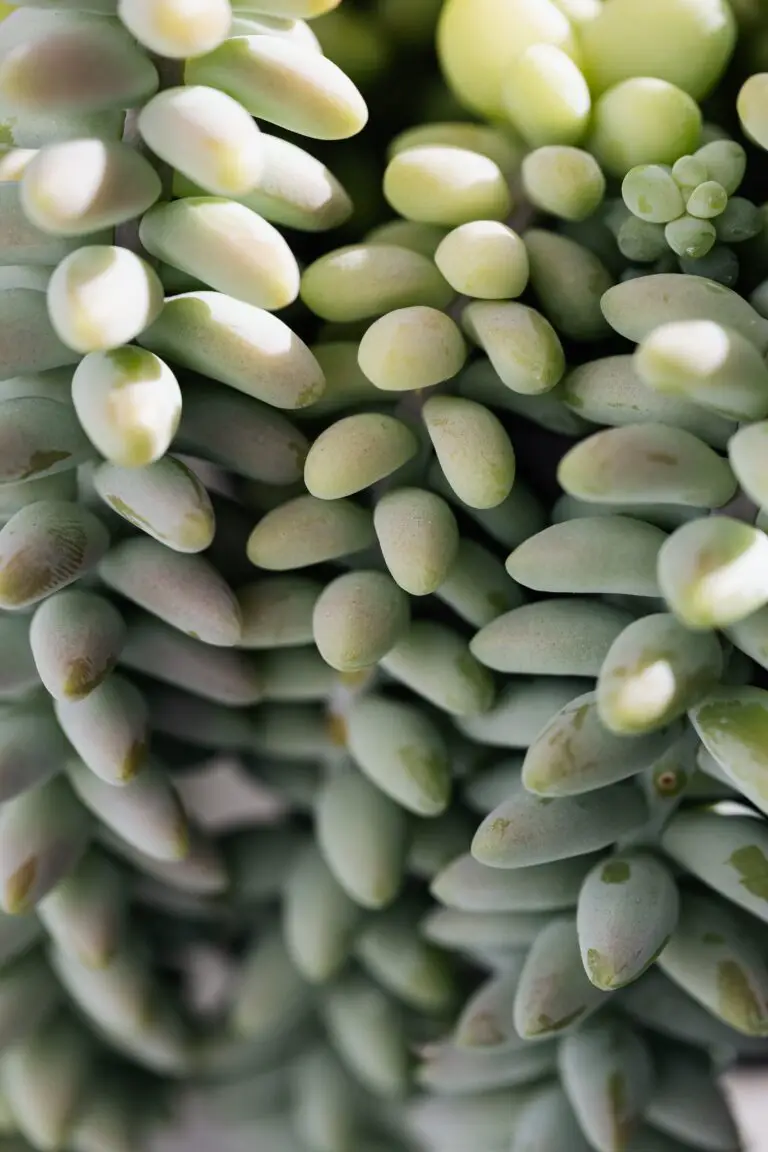
Rock gardens are a quintessential match for the sedum flower. With a variety of shapes, colors, and sizes, sedums seamlessly blend into the rocky terrain, offering a natural aesthetic apt for these zen-like spaces. They mimic the rugged beauty of alpine landscapes, creating a miniature nature reserve right in your backyard. Need inspiration for your rock garden designs? Check out these gorgeous ideas that can transform your landscape into a work of art.
In the world of garden borders, sedum flowers stand out with their unique foliage and star-shaped blooms. Think of them as the perfect transitional actors between different garden areas, providing continuity and a splash of color. Whether you’re looking to create a soft edge for your vegetable patch or a vibrant border for your walkway, sedums can deliver the desired visual impact without overshadowing their garden neighbors.
But don’t overlook the sedum flower as a brilliant ground cover candidate. Imagine a lush, living carpet, stippled with the pink, white, or yellow blossoms of low-growing sedums, creating an enchanting backdrop that requires almost no effort to maintain. These ground covers are not just pretty faces—they’re workhorses that suppress weeds, retain soil moisture, and provide year-round interest, making them a gardener’s dream companion.
Sedum flowers aren’t just survivors; they thrive under a variety of conditions, making them the ideal choice for gardeners who want both beauty and brawn. By introducing sedum into different sections of your garden, you invite a versatile, stress-free charisma that’s tough to match. With their succulent leaves and enduring nature, they’ll quickly become the cornerstone of your garden’s design narrative.
Remember, your garden is a story, and sedum flowers are the enigmatic characters that will keep that story vibrant through the seasons. So why not bring these resilient beauties into your garden and watch the magic unfold?
Benefits of Growing Sedum
When it comes to resilient garden champions, sedum plants take the stage with grace and vigor. The ecological benefits of these hardy perennials reach beyond their striking beauty and into the core of our ecosystems. Let’s delve into the world of sedums and discover how they contribute to a thriving environment.
Attracting a Buzz of Activity
Picture a busy highway of pollinators; that’s what your garden becomes with the introduction of sedum plants. These succulent powerhouses are like all-day diners for bees, butterflies, and other beneficial insects, offering a rich source of nectar. With sedum’s star-shaped blooms, expect a delightful orchestra of buzzing and flitting as these tiny visitors work to maintain the balance of our ecosystem.
A Lesson in Water Wisdom
In an era where every drop counts, sedums are the unsung heroes of water conservation. These plants thrive in dry conditions, requiring minimal hydration. By incorporating sedums into your landscape, you can reduce your garden’s thirst and pave the way for a more sustainable and water-wise green space. Imagine the difference you can make during the hot summer months—sedums standing tall and vibrant, while other plants wither without constant watering.
Guardians of the Ground
Soil erosion: it’s a silent threat to our lands, but sedum plants stand guard against it. Their dense mat of foliage and interconnected root systems lock soil in place, making them an excellent choice for those sloping areas in your garden where nothing else seems to hold. Sedums aren’t just plants; they’re miniature fortresses that protect your soil from being washed away with every rainstorm.
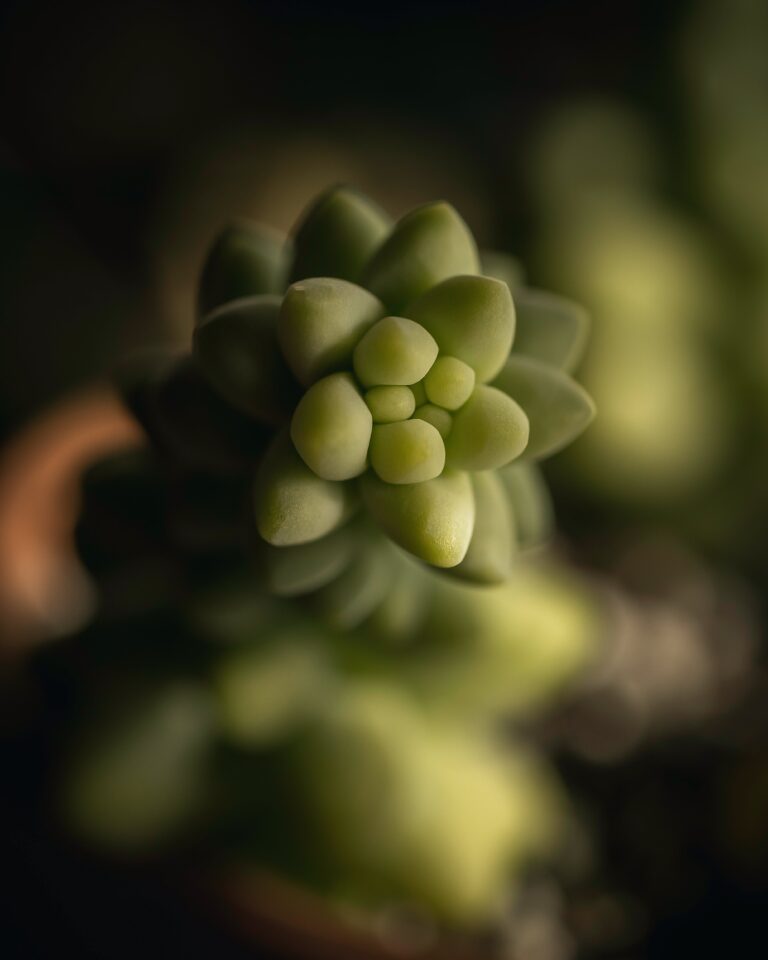
Propagating Sedum: Cultivating Your Own Carpet of Color
If you’ve marveled at the resilient splendor of the sedum flower, often blanketing landscapes in vibrant hues, you might be itching to spread this beauty throughout your own garden space. But how, you ask? Through the rewarding process of propagation! Imagine, just a few small leaf cuttings or divisions from your current plants could soon translate into an entire tapestry of sedum bliss. Let’s dive into the surprisingly simple world of sedum propagation and unearth the secrets to multiplying these hardy gems.
Starting with Leaf Cuttings: Nature’s Puzzle Pieces
One of the most magical aspects of sedum plants is their ability to regenerate from just a single leaf. Think of each leaf as a piece to a natural puzzle, one that holds the potential to become a whole new plant. By gently twisting off a healthy leaf and laying it atop a mix of well-draining soil, you’ve taken the first step towards creating new growth. It’s like a garden party where everyone brings a plus one!
Divide and Conquer: Multiply Your Sedums
For those larger sedum varieties, division is the way to go. Just like a family recipe, dividing sedums allows you to keep the heritage growing. Once the parent plant is established, simply split it into sections with a sharp knife or spade, ensuring that each division has a portion of the root system. It’s like giving each sedum its new plot in life, where it can thrive on its own and contribute to the diversity of your garden narrative.
Seeding a New Generation: Sedum’s Tiny Starters
And let’s not overlook the humble beginnings of all plants—the seed. Starting sedums from seeds can be a test of patience but think of the excitement when those tiny seedlings push through the soil, eagerly reaching for the sun. By sowing seeds directly into the garden or in starter pots, you’re essentially casting a spell of greenery, waiting for the sedum spell to manifest itself in delicate sprouts.
Picture a small, determined seed growing into a flourishing sedum plant, and you’ve got a real-life example of nature’s tenacity. And before you know it, the sedum flower, with its multitude of faces and forms, will proudly stand in your garden, a testament to your dedication as a gardener.
Here’s a little visual inspiration for you. Take a peek at this video and see just how quickly and easily sedum can be propagated and transformed into a spreading ground cover. Prepare to be amazed!
With the right approach and a touch of plant-parent intuition, your sedum sanctuary could soon bloom into existence. Whether it’s by leaf cuttings, divisions, or seeds, each method opens up a new doorway to expanding your collection. It’s a choose-your-own-adventure story in the garden, with sedum as the protagonist, ever ready to fill your outdoor space with lush, drought-tolerant beauty!
Common Pests and Problems in Sedum Flowers
Sedums, with their succulent leaves and hardy nature, are generally robust plants. However, like all garden residents, they’re not completely immune to trouble. These perennial beauties can sometimes fall prey to pests and diseases, making their resilience a little less foolproof. Below, we delve into some of the common issues Sedum flowers may encounter and arm you with knowledge to stand guard against these invasive forces.
One of the most common foils to the Sedum’s easy-care reputation are aphids. These tiny, insatiable critters flock to the tender shoots and undersides of leaves, draining the life from your plants. They’re like the vampires of the garden, only less charming and more destructive. If you notice your Sedum’s leaves starting to curl or look discolored, it might be time to play detective and check for these pesky insects.

Fungal diseases also loom as a threat to Sedum flowers. Powdery mildew, as the name suggests, shows up like a fine, powdery white coating atop the leaves, often during times of high humidity. It’s the plant world’s equivalent of catching a cold because someone sneezed across the room. While it isn’t deadly, it’s certainly not a good look and can weaken your plants over time. Then there’s the dreaded root rot, which can result from overly enthusiastic watering or poor drainage. This essentially drowns your sedum’s roots, cutting short its bright future in your garden.
Environmental stress shouldn’t be underestimated either. Even the mighty sedum has its limits. Too little light, and they can become leggy, stretched out like they’re trying to pull themselves up to catch those elusive sunbeams. On the flip side, a scorching summer sun can sunburn their leaves, reminding us that even plants can have too much of a good thing.
Thankfully, with the right knowledge, these issues can be managed or prevented. Regular inspections for aphids and prompt treatment with insecticidal soap or neem oil can help keep these tiny vampires at bay. Ensuring good air circulation and avoiding overhead watering can prevent fungal nightmares like powdery mildew. As for environmental concerns, pay attention to your Sedum’s needs, tailoring their placement and care to meet the unique contours of your garden ecosystem.
Remember, every garden tells a story, and with a watchful eye and a bit of TLC, your Sedum flowers can continue to be the resilient, beautiful stars of that tale.
Seasonal Care and Tips for Sedum Flowers
When it comes to year-round brilliance, the resilient sedum flower stands out like a beacon in the garden! These hardy succulents usher in a symphony of color and texture across the seasons, but they do so in stride—they’re not prima donnas of the plant world. Rather, they’re akin to the cool, collected jazz musicians who improvise beautifully regardless of the weather notes thrown at them. Let’s riff through the seasons with some care and tips for your sedum flower jam session!
Winter Whispers: Preparing Your Sedum
Think of winter as the rest between melodies—it’s a vital pause for sedum. As the temperature dips, your green notes might look a little off-key. But fear not, strategically cutting back the foliage after the first frost sets the stage for nature’s springtime resurrection. It’s pretty simple: snip the spent flowers, protect the crown from waterlogged solos with a bit of mulch, and let the plant hibernate under the snow. They’ll be dreaming of their upcoming solo!
Spring Serenade: Awakening Your Sedum
Come spring, your sedum is ready to crescendo! As green shoots emerge, like strings tuning up in an orchestra, remove any remaining winter dissonance by clearing away old mulch and dead material. This is the perfect moment to divide those over-enthusiastic sedum clumps that have grown larger than their pots and to spread their joy to other garden nooks. A light feeding now sets the perfect pitch for vibrant growth.
Summer Jazz: Playing It Cool with Sedum
When the summer heat hits, sedum is like that smooth saxophone—unfazed, still shining. The key to a sedum’s summer jam is “less is more.” Too much water? You’ll drown the beat. Stick to the rhythm of occasional, deep watering sessions that encourage roots to seek moisture, keeping plant bass-lines strong and healthy. Deadhead as needed to help new buds take their turn in the spotlight. And don’t fret if the encore of flowers takes a mid-season break; they’ll be back for the autumnal show!
Imagine this: It’s summer, the sun is blazing, and there you are, lounging in your garden, admiring the drought-tolerant sedum that seems to sway with the sultry breeze, needing no more than a nod of acknowledgement to keep up their splendid performance. This is the living embodiment of low maintenance finesse.
Autumn Acoustics: Encore Appearances
As fall paints the garden with warm tones, your sedum flowers take the stage one last time. Like an experienced band returning for an encore, they burst forth in rich hues—fiery reds, radiant yellows. Now is the time for gentle upkeep; give your plants a once-over, removing any out-of-tune stems. Let them fade naturally as the season winds down, providing that essential late-season nectar for local pollinators, like an enduring beat that keeps the garden’s heart thumping.
By the time the curtain falls on autumn, sedum stands in all its glory, a stalwart performance lasting through the chills. This is no somber goodbye; it’s a smooth transition, a whisper of promises for next year’s symphony. In the distance, a sedum catches the orange glow of the setting sun, painting a masterpiece in the garden—an homage to resilience and an echo of beauty yet to come.
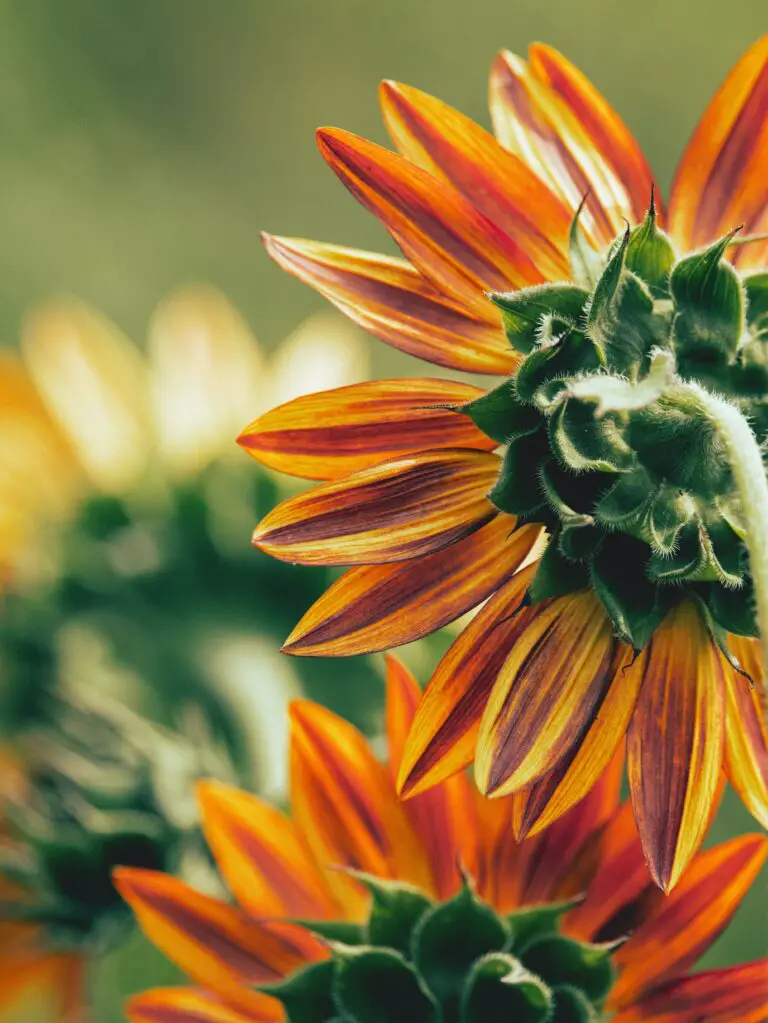
FAQs About Sedum Flowers
With the growing popularity of sedum flowers in gardens, many enthusiasts are buzzing with questions on how to best care for this resilient beauty. So, let’s dig into some real-world scenarios and provide the lowdown on nurturing your sedums to perfection!
How do I plant sedums for the best chances of success?
Think about planting sedums like you’re setting up a playdate between the sun and your new green friend. These plants adore sunlight, and they thrive in well-draining soil that doesn’t leave their “feet” wet. A spot that gets at least 6 hours of sunshine is ideal. If you opt for container gardening, remember to check for drainage holes—sedums despise soggy conditions almost as much as cats dislike water!
Here’s a pro tip: Plant them alongside other drought-tolerant buddies, like lavender or salvia, for a low-maintenance garden that’s as hardy as it is beautiful.
What type of maintenance do sedum plants require?
Maintenance for sedums is easier than convincing a kid to eat candy. These plants are self-sufficient and can handle neglect quite well. However, a bit of TLC can go a long way. During the growing season, watering them during extended dry spells will keep them happy. But once established, they are the Chuck Norrises of the plant world—pretty tough! If you notice your sedum starting to sprawl or look a bit untidy, a gentle trim will encourage bushier growth and maintain its compact form.
Check out this video for more in-depth care tips on a variety of sedum plants:
Can I grow sedums in cold climates?
If you’re living in a spot that gets colder than a snowman’s pocket, fear not—sedums are champs in cold weather too! These plants are surprisingly hardy, with many varieties thriving in USDA hardiness zones 3 through 9. They’re like the polar bears of the plant kingdom, snug and happy despite the chill. Just make sure to provide them with well-draining soil to prevent waterlogging in winter, which can lead to root rot, the villain of many plant tales.
Are sedum flowers pet-friendly?
Dog and cat parents, rejoice! Sedum plants generally get the green light for being non-toxic to pets. So your furry companions can frolic freely in the garden without a worry. Just keep an eye out for any potential nibbling—a surplus of any plant munchies can lead to stomach upset in pets, and we don’t want those wagging tails to stop, do we?
Remember that while sedums are tough cookies, they love a bit of attention now and then. Treat them right, and they’ll provide a symphony of color and texture to your garden orchestra. Happy planting!

